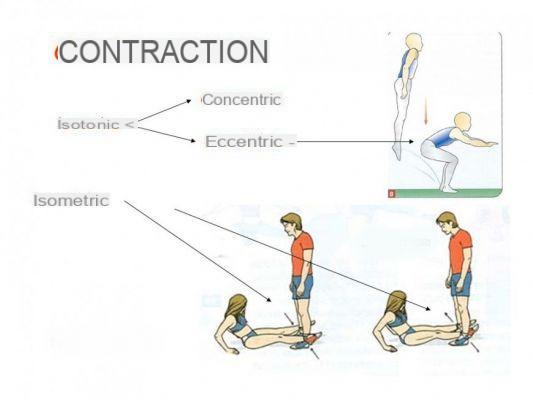
- esercizi which involve muscle strain may be also classified according to the length and tension of the engaged muscle.
Depending on the case, we talk about exercises isotonici o isometrici.
Isotonic and isometric movements
They define themselves isotonici the exercises that behave an eccentric phase or lowering and a concentric phase or lifting.
Exercises isometrici, on the other hand, they do not produce joint movement but they develop tension within the muscle to support a load.
Both the types of exercises can be used for develop muscle stability and endurance. Exercises isotonici however they are generally best for increasing functional strength and mass.
Isotonic exercises
Exercises isotonici they subject the muscles to a movement performed under the strain of a constant static weight. During the execution the muscle must overcome a more or less high resistance to be able to carry out the movement, and with the passage of time it will tend to develop, becoming stronger.
Concentric or eccentric isotonic exercises
Isotonic exercise may be further divided into two categories: concentric and eccentric.
Exercise concentric it occurs when a contraction causes a muscle to shorten. For example, the bicep shortens when the elbow bends during a dumbbell curl.
Exercise eccentric instead occurs when a muscle not only contracts, but also stretches. Lowering a dumbbell to the exercise start position is an example of an eccentric exercise.
Isotonic isolation exercise
Another sub-category is that of isotonic isolation exercises, which involve the carrying out a movement around a single joint. They are usually used to train specific areas of the body.
Examples of isotonic isolation exercises are leg extensions, leg curls, seated and standing calf raises, lateral shoulder raises, front shoulder raises, pectorals, and preacher curls.
The main muscle involved in producing joint movement is called the agonist and is the target muscle in this type of exercise.
Compound isotonic movement
There is also movement compound isotonic, which contrary to the previous one occurs in more than one joint. Over to request an agonist, compound exercises they also recruit muscles called synergists to assist in the movement. The latter tend to be smaller than the agonists.
Compound exercises are generally more functional than isolation exercises, as they mirror everyday or sporting movements and have practical application in real-life activities.
Examples of compound isotonic exercises include push-ups, pull-ups, presses, squats, lunges, and dead lifts.
How to perform a push-up
One of the best known isotonic exercises is the push-up.
- To do this, get into the plank position, keeping the abdominal muscles contracted, the neck in a neutral position and the hands under the shoulders.
- Lower the body by bending the elbows and keeping them turned slightly towards the lower limbs.
- Go down until your chest touches the floor.
- Remain in that position for a few seconds and then straighten the elbows and push the body upwards to return to the starting position.
- Repeat the movement as desired.
During the entire duration of the performance, remember to keep your back straight.
Isometric exercises
In isometric exercises there is no movement of the joints or of the muscle ma if it maintains the latter in tension without moving it for a series of seconds and the exercise is repeated for a predetermined number of times.
One of the main benefits of isometric exercise is that it does not require any equipment and therefore it is ideal to be done at home.
Exercises for the lower body
This typology is particularly suitable for training the lower part of the body, which contains most of the overall muscle mass.
Keeping this area of the body strong and well developed can make everyday activities like walking, climbing stairs, and standing easier.
Examples of isometric exercises for the lower body are the wall squat hold, the hip bridge, the static lunge, the static knee extension and its pull against a pillow or small medicine ball.
How to do the hip bridge
- Lie on your back, with your knees bent and with your whole foot resting on the floor.
- Raise the pelvis so that the body forms a straight line from the knees to the shoulders.
- Hold the position for 30 seconds, then lower your pelvis.
- To increase the difficulty, perform the exercise with one leg straight and raised.
- Do repetitions of 30 seconds each.
Exercises for the upper body and the core
Although the upper body and core represent a smaller muscle area than the lower body, these muscles are no less important because they help lift heavy objects by supporting the spine, stabilizing the shoulders and encouraging good posture.
Strength can be increased in upper body exercises by doing isotonic pushups or pull-ups, plank, side plank, abdominal pull, wrestler's bridges, and isometric crunches.


























